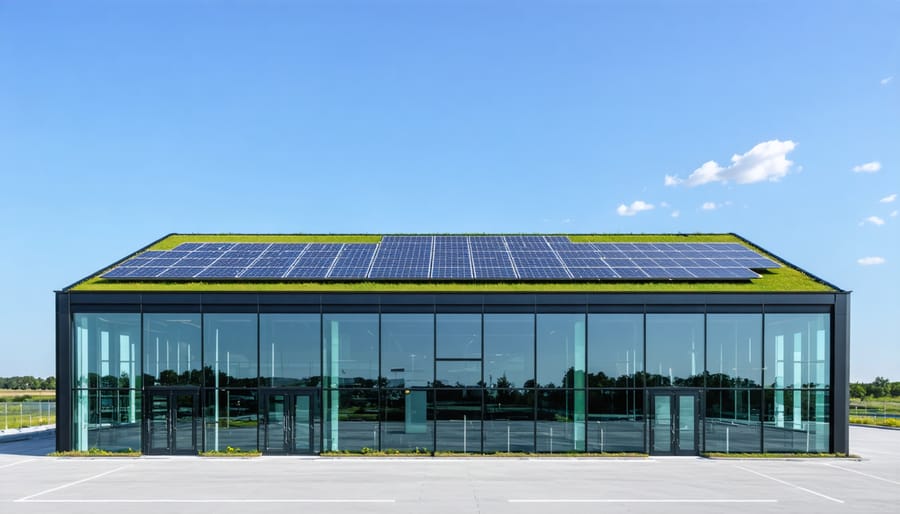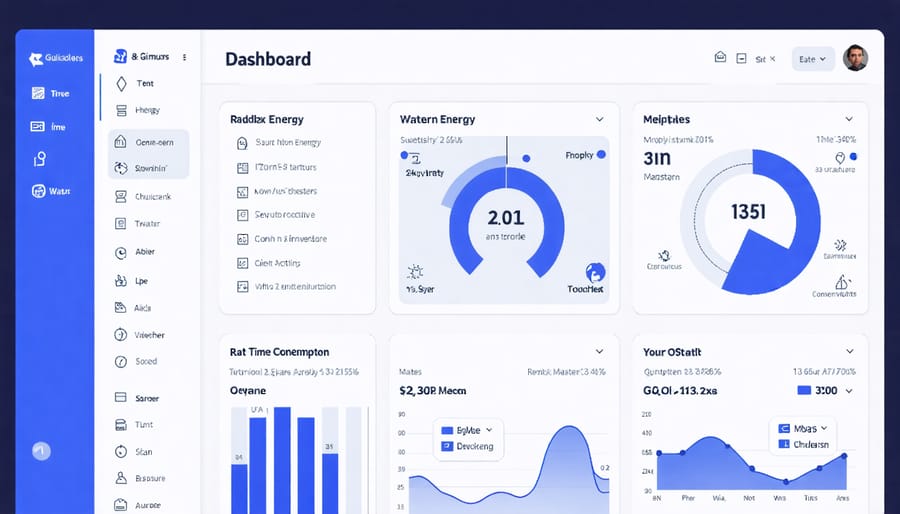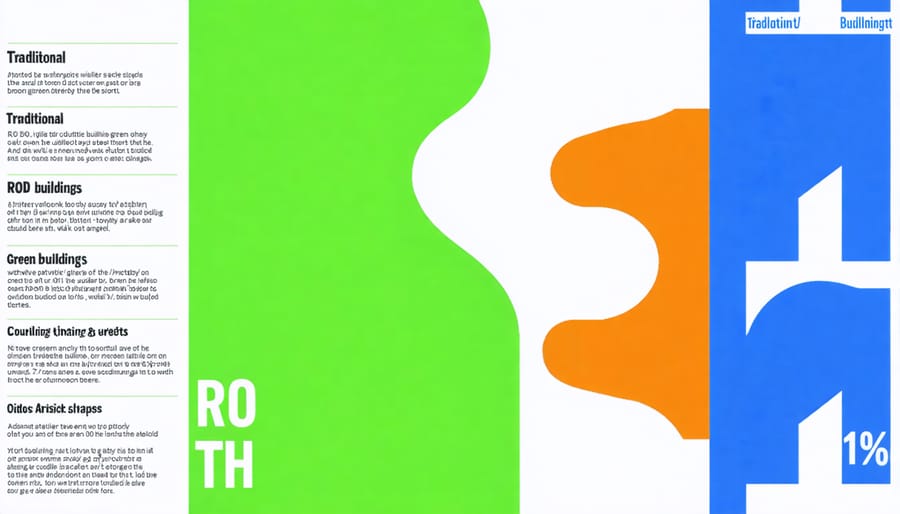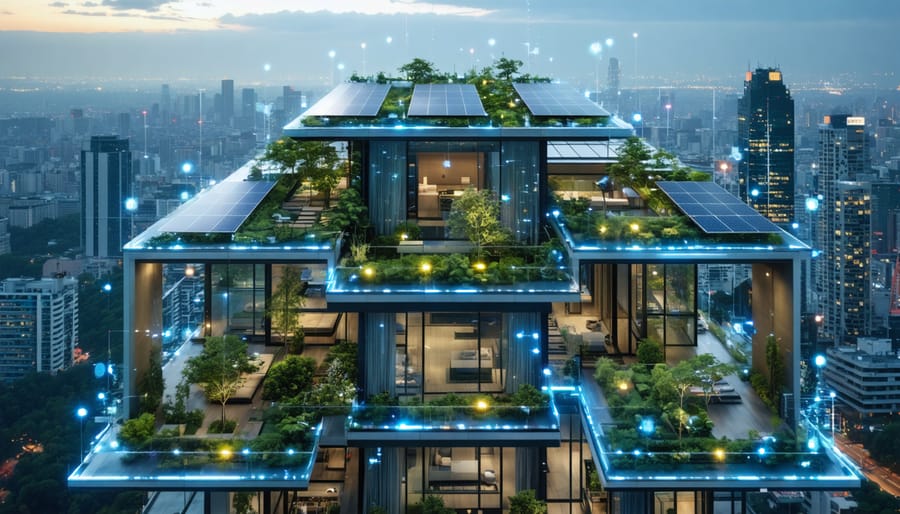Transforming real estate portfolios through sustainable practices has become a critical imperative, not just an environmental choice. As global markets shift toward carbon neutrality and ESG compliance, property developers and managers who fail to embrace sustainable solutions risk significant value depreciation and reduced market competitiveness. Recent data from the World Green Building Council demonstrates that sustainable buildings command 7-11% higher rental premiums and maintain 23% above-average occupancy rates, while reducing operational costs by up to 37% through energy-efficient systems and smart building technologies.
The convergence of strict environmental regulations, increasing tenant demands for green spaces, and the rising cost of traditional energy sources has created an unprecedented opportunity for real estate professionals to reimagine their asset management strategies. From LEED certification requirements to net-zero carbon commitments, sustainability has evolved from a market differentiator to an essential business practice that drives long-term value creation and resilience in real estate portfolios.
This transformation extends beyond simple energy efficiency measures to encompass comprehensive approaches in design, construction, operations, and end-of-life considerations. Forward-thinking real estate professionals are now integrating circular economy principles, renewable energy systems, and advanced building management technologies to create properties that not only minimize environmental impact but also maximize financial returns and occupant well-being.

Energy-Efficient Building Systems: The Foundation of Sustainable Properties
Smart HVAC Solutions
Modern HVAC systems have emerged as cornerstone elements of sustainable real estate, representing one of the most impactful innovative building technologies in the industry. Smart HVAC solutions combine advanced sensors, machine learning algorithms, and automated controls to optimize building performance while significantly reducing energy consumption.
These systems utilize real-time data analytics to adjust temperature, humidity, and ventilation based on occupancy patterns, weather conditions, and time-of-day usage. Building automation systems (BAS) integrate with HVAC controls to create a comprehensive energy management platform, capable of reducing operational costs by 20-30% compared to traditional systems.
Key features of modern HVAC solutions include variable refrigerant flow (VRF) systems, which allow for simultaneous heating and cooling in different zones, and smart thermostats that learn from occupant behavior. Advanced heat recovery ventilators (HRV) systems capture and reuse thermal energy from exhaust air, while demand-controlled ventilation adjusts fresh air intake based on CO2 levels and occupancy.
Implementation of these systems requires careful planning and integration with existing building infrastructure. ROI analysis typically shows payback periods of 3-5 years, with significant long-term benefits in operational efficiency and occupant comfort. Regular monitoring and preventive maintenance ensure optimal performance and extended system longevity.
LED Lighting and Smart Controls
LED lighting technology has revolutionized energy efficiency in commercial real estate, offering up to 75% reduction in energy consumption compared to traditional lighting systems. Modern LED installations not only provide superior illumination but also last significantly longer, with typical lifespans exceeding 50,000 hours of operation.
Smart control systems enhance these benefits through sophisticated automation and monitoring capabilities. Occupancy sensors, daylight harvesting systems, and programmable timers work in concert to optimize lighting levels based on actual usage patterns and natural light availability. These systems can automatically adjust brightness levels and shut off lights in unused areas, further reducing energy waste.
Building managers are increasingly implementing IoT-enabled lighting solutions that integrate with building management systems (BMS). These smart networks provide real-time data on energy consumption, maintenance requirements, and space utilization. For example, the Deutsche Bank headquarters in Frankfurt achieved a 67% reduction in lighting energy costs through LED retrofit and smart controls implementation.
Advanced dimming capabilities and color temperature adjustments support human-centric lighting designs, improving occupant comfort while maintaining efficiency. Many systems now offer mobile app control and detailed analytics dashboards, enabling facility managers to fine-tune settings and demonstrate ROI through comprehensive energy savings reports.
The initial investment in LED lighting and smart controls typically yields returns within 2-3 years through reduced energy costs and maintenance requirements, making it a cornerstone of sustainable building operations.
Water Conservation and Waste Management Strategies

Smart Water Management Systems
Smart water management systems represent a crucial component in modern sustainable real estate development, combining advanced monitoring technologies with efficient distribution networks. These systems integrate IoT sensors, automated controls, and data analytics to optimize water consumption across properties while reducing operational costs.
Key technologies include smart meters that provide real-time consumption data, leak detection systems that can identify problems before they escalate, and automated irrigation controls that adjust watering schedules based on weather conditions and soil moisture levels. Building managers can monitor usage patterns through centralized dashboards, enabling quick responses to anomalies and informed decision-making.
Advanced greywater recycling systems are increasingly being incorporated into new developments, allowing treated wastewater to be repurposed for non-potable applications such as toilet flushing and landscape irrigation. These systems can reduce freshwater consumption by up to 30-50% in commercial buildings.
Digital pressure management solutions help maintain optimal water pressure throughout building systems, preventing waste and reducing the risk of pipe damage. When combined with smart fixtures like low-flow faucets and dual-flush toilets, these technologies create a comprehensive water conservation strategy that meets both environmental goals and regulatory requirements while delivering significant cost savings over time.
Industry leaders are now implementing AI-driven predictive maintenance programs that can forecast potential system failures and optimize maintenance schedules, further enhancing water conservation efforts.
Zero-Waste Initiatives
Zero-waste initiatives in real estate development have emerged as a crucial component of sustainable construction and property management. Leading developers are implementing comprehensive waste reduction programs that typically achieve 70-90% diversion rates from landfills during construction and operations phases.
Construction waste management programs focus on three key strategies: source reduction, material reuse, and recycling. Successful implementations include dedicated sorting areas on construction sites, partnerships with specialized recycling facilities, and detailed waste tracking systems. For example, the One World Trade Center project achieved an impressive 87% waste diversion rate through systematic material separation and innovative recycling solutions.
During operational phases, property managers are adopting smart waste management systems that include automated sorting, composting programs for organic waste, and tenant education initiatives. These systems often incorporate IoT sensors to optimize collection schedules and reduce transportation emissions.
Notable success stories include major office complexes implementing centralized recycling stations, achieving waste reduction of up to 60% within the first year. Multi-family residential properties have found success with on-site composting programs, reducing organic waste by up to 40% while creating valuable fertilizer for landscaping.
Cost analysis shows that zero-waste initiatives typically result in 15-30% reduction in waste management expenses, making them both environmentally and financially sustainable.
Green Building Certifications and Compliance
Green building certifications have become essential benchmarks for sustainable real estate development, with several prominent programs setting industry standards. LEED (Leadership in Energy and Environmental Design) remains the most widely recognized certification system globally, offering various rating levels based on building performance across multiple sustainability criteria.
BREEAM (Building Research Establishment Environmental Assessment Method), particularly prevalent in Europe, provides another comprehensive framework for assessing, rating, and certifying building sustainability. The system evaluates properties across categories including energy, water, materials, waste, and indoor environmental quality.
The WELL Building Standard has gained significant traction, focusing specifically on occupant health and wellness through air quality, comfort, nutrition, and mental health considerations. This certification has become increasingly important as tenants and investors prioritize healthy building environments.
Energy Star certification, administered by the U.S. Environmental Protection Agency, specifically targets energy efficiency performance. Buildings must achieve a score of 75 or higher, indicating they perform better than at least 75% of similar buildings nationwide.
Regulatory compliance requirements vary by jurisdiction but typically include minimum energy performance standards, waste management protocols, and greenhouse gas emissions reporting. In the United States, state and local governments increasingly mandate benchmarking and performance standards for commercial buildings. For example, New York City’s Local Law 97 requires large buildings to meet strict carbon emissions limits by 2024.
The certification process typically involves:
– Initial assessment and registration
– Documentation of sustainable features and practices
– Third-party verification
– Regular performance monitoring and reporting
– Recertification at specified intervals
While certification costs can be significant, the return on investment often justifies the expense through increased property value, higher occupancy rates, and reduced operating costs. Additionally, many jurisdictions offer tax incentives and expedited permitting for certified green buildings, making certification both an environmental and financial imperative for modern real estate development.
The Business Case for Sustainable Property Management
Operating Cost Reduction
Implementing sustainable practices in real estate properties consistently demonstrates significant operational cost reductions across multiple areas. Energy-efficient systems, including LED lighting, smart HVAC controls, and improved insulation, typically reduce utility expenses by 25-35% annually. According to recent industry studies, buildings with comprehensive energy management systems save an average of $0.50-$1.00 per square foot in annual operating costs.
Water conservation measures, such as low-flow fixtures and smart irrigation systems, contribute to additional savings of 15-20% on water bills. Modern sustainable buildings also benefit from reduced maintenance costs, with high-efficiency equipment requiring less frequent repairs and replacement. Energy-efficient HVAC systems, for instance, have shown to decrease maintenance expenses by up to 40% over their operational lifetime.
Waste management initiatives, including recycling programs and composting systems, can reduce waste disposal costs by 30-50%. Furthermore, sustainable properties often qualify for tax incentives, grants, and utility rebates, providing immediate financial benefits. A comprehensive analysis of 200 commercial buildings revealed that LEED-certified properties reduced their operating costs by an average of $0.75 per square foot annually.
The return on investment for sustainable upgrades typically ranges from 3-7 years, with some high-impact improvements, like LED lighting retrofits, showing payback periods as short as 12-18 months. These cost reductions directly improve net operating income and property value, making sustainability investments increasingly attractive to property owners and investors.

Tenant Satisfaction and Retention
Sustainable buildings are increasingly becoming a key factor in tenant satisfaction and retention, with research showing that environmentally conscious properties command higher occupancy rates and longer lease terms. Studies indicate that green-certified buildings experience 20% lower tenant turnover rates compared to conventional properties, demonstrating the direct correlation between sustainability and tenant loyalty.
The implementation of advanced property management services focused on sustainability has shown to enhance tenant experience through improved indoor air quality, better temperature control, and reduced utility costs. These benefits translate into measurable improvements in tenant productivity and well-being, with occupants reporting 26% higher satisfaction rates in green buildings.
Property value appreciation is another significant outcome of sustainable practices. Green-certified buildings typically command 7-10% higher rental premiums and demonstrate stronger value retention during market fluctuations. This premium is driven by both tenant demand and lower operating costs, creating a compelling business case for sustainability investments.
The data shows that properties implementing comprehensive sustainability programs experience up to 30% reduction in tenant complaints related to comfort and building performance. This decreased maintenance burden, combined with lower utility costs and higher tenant satisfaction, creates a positive feedback loop that supports both property value and long-term tenant relationships.
Future-Proofing Properties Through Sustainability
In today’s rapidly evolving real estate landscape, future-proofing properties through sustainable practices has become paramount for long-term asset value and operational efficiency. The future of property management is increasingly defined by innovative technologies and smart building solutions that optimize resource consumption and reduce environmental impact.
Leading construction professionals are implementing Building Management Systems (BMS) integrated with IoT sensors to monitor and optimize energy usage in real-time. These systems collect valuable data on occupancy patterns, temperature fluctuations, and equipment performance, enabling predictive maintenance and reducing operational costs.
Emerging trends include the adoption of renewable energy microgrids, which provide properties with energy independence and resilience. Advanced building materials, such as self-healing concrete and smart windows with automated tinting, are revolutionizing building envelope performance. Water conservation technologies, including gray water recycling systems and smart irrigation, are becoming standard features in sustainable properties.
To ensure long-term viability, property developers are also incorporating flexible design principles that allow for future modifications as sustainability requirements evolve. This adaptability, combined with regular sustainability audits and continuous improvement protocols, positions properties to meet increasingly stringent environmental regulations while maintaining their market value and attractiveness to environmentally conscious tenants.
Implementing sustainable practices in real estate is no longer optional but essential for long-term success in the industry. Property managers must take decisive action to integrate green building technologies, energy-efficient systems, and sustainable management practices into their operations. The evidence clearly demonstrates that sustainable properties not only reduce environmental impact but also deliver significant cost savings and increased asset value.
To move forward effectively, property managers should prioritize energy audits to identify improvement opportunities, implement smart building management systems, and develop comprehensive waste reduction programs. Investment in renewable energy solutions, particularly solar installations and energy-efficient HVAC systems, consistently delivers strong returns on investment while reducing operational costs.
Success in sustainable real estate management requires commitment to continuous improvement and stakeholder engagement. Property managers should establish clear sustainability metrics, regularly monitor performance, and maintain transparent communication with tenants and investors. By adopting these recommendations and staying informed about emerging green technologies, property managers can position their assets for long-term success while contributing to environmental conservation and meeting evolving market demands.

